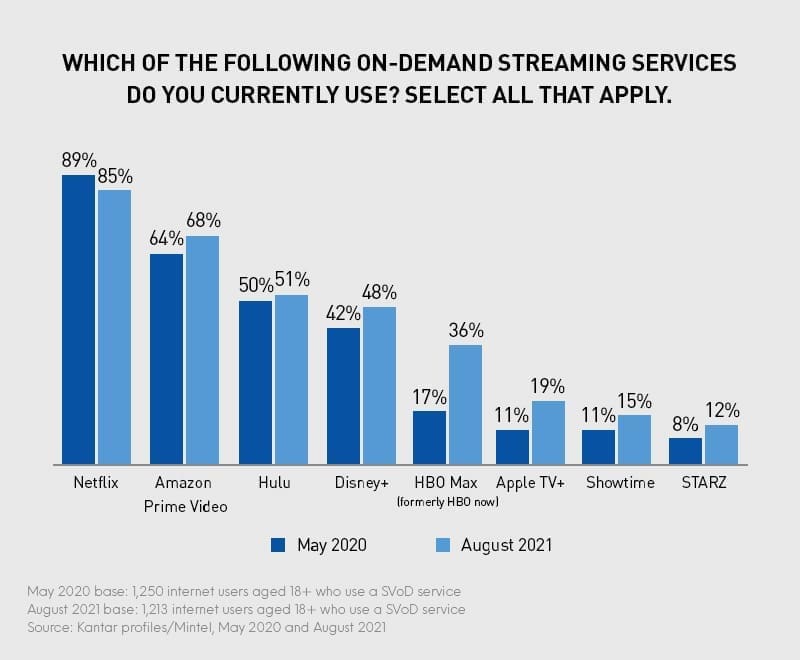Netflix can’t seem to stay out of the news―making headlines with its deal with Comcast to help ensure speedier service; following up on the latest season of “House of Cards”, which has seemingly monopolized social media feeds everywhere―everything the streaming video giant does rapidly becomes digital water cooler fodder. Mintel research finds that Netflix accounts for 90% SOV (share of voice) across leading streaming video services. That’s a whole lot of Tweets. One in four US households carries Netflix, creating widespread interest in everything it does.
Beyond headlines and social media, the enormous size of Netflix’s subscriber base gives the brand the ability to actually change digital media consumption. Between their recent deal with Comcast and adoption of 4K (also known as Ultra High Definition, due to replace 1080p as the highest-resolution signal available), Netflix will impact hardware and ISP sales for the next five years. Netflix needs streams of 20 Mbps to deliver 4K, so ISPs need to convince consumers to sign on for ultra-wideband service and 4K is likely to be the primary driver for it. The price of 4K televisions has dropped to the $1,000 mark but the lack of any physical storage format for 4K means if consumers want 4K, they’ll need to stream it. ISPs and Netflix now have the same agenda and a winning formula.
4K is going to be a good thing not only to ISPs, but also the hardware industry – in the absence of 4K screens, there’s little point in streaming in 4K. While only 500,000 4K TVs are expected to sell in 2014, the availability of 4K to 33 million Netflix households will likely result in much more rapid adoption of 4K than would otherwise have been seen. The boon to hardware sales will not stop there – consumers may want 4K on their PCs, tablets and even smartphones, even if the difference to the eye is limited on the latter. 4K also creates opportunities for Amazon, Apple, Hulu and other streaming leaders, enabling them to charge a higher premium for the ultra-HD, while potentially keeping the price the same for their current HD offerings. Everybody wins, except consumers’ pocket books.
Looking backwards, Netflix has already changed media consumption by releasing entire seasons of television, prompting widespread “binge-watching”. Marathon viewing sessions are not new – they have been offered by television channels on holiday weekends for decades, typically saluting prolific, popular filmmakers or television programming with cult followings. However, with today’s streaming video services, the viewer is now in total command, selecting when the marathon will occur and what the content will be. Whether it’s “Breaking Bad”, “The Walking Dead”, or original Netflix content such as “House of Cards” and “Orange is the New Black”, where entire seasons are released at once, marathon TV-watching sessions have never been so prevalent or convenient.
But it’s not necessarily clear that releasing entire seasons at once benefits the content provider. Netflix co-founder and former CEO Mitch Lowe has expressed concerns with this strategy, calling it a PR stunt and saying that it undercuts the buzz by negating the build-up that comes with weekly episodes. Releasing the entirety of a season at a single time saves the service’s marketing dollars, yet, given the massive costs of producing original content, there is a legitimate case to be made for releasing it on a weekly basis. Even if it means that marketing dollars support only the first few episodes of the season, subscriptions may be lost after the content has been consumed. I cancelled my Hulu subscription after binging through Quick Draw. My Netflix subscription stands in jeopardy for the same reason. As people race through their favorite shows, the need for new content to view becomes immediate and the cost of supplying it, whether through licenses or original productions rises.
Billy is a Senior Media and Technology Analyst at Mintel. He heads the Tech and Media subscription for Mintel’s syndicated reports team, including topics such as consumer electronics, digital entertainment, social networking, digital marketing, pay TV services and online video. He has a particular emphasis on cellular services and mobile hardware and software.








































